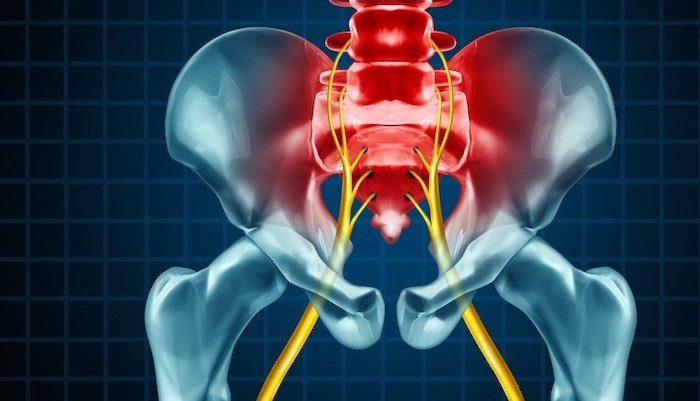
A Frequent Source of Lower Back and Leg Pain
One of the most prevalent causes of low back pain occurs with injuries to the sacroiliac (SI) joint and ligaments. Young and middle-aged women are most susceptible to this condition, which can make sitting and standing difficult and painful tasks. If you are experiencing the painful symptoms of SI joint dysfunction, we can help you find relief with accurate diagnostic techniques and effective non-surgical therapy.
Understanding SI Joint Dysfunction
The SI joint connects the pelvic bone (ileum) to the lowest part of the spine (sacrum). There are two SI joints located on either side of the sacrum. SI joints are small and very strong, providing structural support and stability. They function as shock absorbers for the pelvis and the low back, dispersing the forces of the upper body. When an SI joint is irritated or injured, the resultant joint dysfunction may cause pain in the lower back and legs.
Why SI Joint Dysfunction Occurs
SI joints become painful because of alterations in the normal motion of the joints. There are two types of changes from normal motion that can cause problems. There may be too much movement (hypermobility) or too little movement (hypo-mobility). Abnormal or excessive motion from work or sporting activities can directly injure the joints by stretching or straining the primary SI ligaments. Any of these changes in joint mobility may lead to pain, as well as a spasm in the supporting back and pelvic muscles. SI joint dysfunction may also result from direct trauma, such as injuries associated with a motor vehicle accident, or from something as simple as a fall on the buttocks or a missed step when descending stairs.
The Symptoms of SI Joint Dysfunction
The most common symptom is a pain in the low back that is aggravated by sitting, standing, and bending at the waist. When SI joint dysfunction is severe, there can be referred pain in the hip, groin, and leg.
The Importance of Accurate Diagnosis
Sacroiliac joint dysfunction is difficult to diagnose. This is because the pain patterns associated with SI joint dysfunction are frequently mistaken for nerve irritation in the low back, muscle sprain, or hip bursitis. Our pain management physician understands the intricacies of SI joint mechanics and mobility. Our doctors reach an accurate clinical diagnosis with a thorough, individualized approach that begins with a complete medical history, analysis of the injury, and a musculoskeletal examination of the spine and pelvis. Radiographic studies also assist in this process. They may include x-ray, MRIs, CT scans, and bone scans. These tests, while not necessarily detecting SI joint dysfunction, are extremely important in eliminating other causes of back pain. To ensure accuracy, a non-surgical procedure may be used. Under fluoroscopic (x-ray) guidance, the SI joints and/or ligaments are stimulated and anesthetized to achieve final confirmation of the diagnosis.
Effective Pain Relief Without Surgery
The pain from SI joint dysfunction may be lessened or temporarily relieved with simple measures, such as heat or cold applications, anti-inflammatory medications, rehabilitation, and sacroiliac joint support. For stronger, longer-lasting relief, we offer you other effective, non-surgical therapy options as well.
SI joint injections of anti-inflammatory medication and local anesthetic in the SI joint, ligaments, and surrounding muscle groups can greatly reduce the pain and discomfort for extended periods of time. Radiofrequency Neurotomy creates a longer-lasting result through the application of thermal energy to desensitize the nerve supply to the SI joint.
Advanced regenerative treatments, such as Prolotherapy and Platelet Rich Plasma Therapy, offer significant long-term relief, frequently providing more complete and permanent improvement. All of these procedures are safely performed in a sterile, medical office setting. Proven to be effective, they offer the benefit of alleviating your pain without surgery, without general anesthesia, and without hospital stays or prolonged recovery periods.
Possible Treatments
- Discography
- Joint Injections
- K-Laser Therapy
- Medial Branch Blocks
- Prolotherapy
- Platelet Rich Plasma (PRP Therapy)
- Radiofrequency Neurotomy
- Si Joint Injection
- Stem Cell Therapy
Precision Pain Care and Rehabilitation has two convenient locations in Richmond Hill – Queens and New Hyde Park – Long Island. Call the Richmond Hill office at (718) 215-1888, or (516) 419-4480 for the Long Island office, to arrange an appointment with our Interventional Pain Management Specialist, Dr. Jeffrey Chacko.















